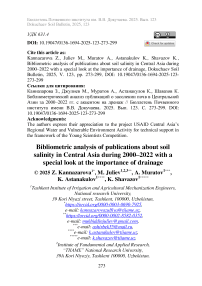Bibliometric analysis of publications about soil salinity in Central Asia during 2000–2022 with a special look at the importance of drainage
Автор: Kannazarova Z., Juliev M., Muratov A., Astanakulov K., Shavazov K.
Журнал: Бюллетень Почвенного института им. В.В. Докучаева @byulleten-esoil
Статья в выпуске: 123, 2025 года.
Бесплатный доступ
Soil salinity is a serious disaster in many arid and agricultural regions, especially in Central Asia. The extensive economic impact of soil salinization on the national economy of Central Asian countries is significant. To solve the above problem, three systems are of great importance: drainage system, high-quality land leveling (planning) and salt washing activities. The aim of this study to review published articles on the issue of the term of soil salinity regions in Central Asia from 2000 to 2022. Aligning with this aim, we have collected, reviewed, and analyzed 661 publications, met the selection criteria in the Scopus database during 2000–2022. Bibliometric analysis showed that all articles were published in English, with the highest publication numbers coming from the Uzbekistan, Kazakhstan, Germany, China, the Russian Federation and the United States. The bibliometric analysis showed that international research on soil salinity and importance of drainage system is needed to expand the scientific exchange on this topic, as well as long-term, continuous research and sustainable development of soil salinization concepts for future agriculture and soil salinity management integration will be useful.
Salinization, Scopus, citations, research trend, review
Короткий адрес: https://sciup.org/143184479
IDR: 143184479 | УДК: 631.4 | DOI: 10.19047/0136-1694-2025-123-273-299
Текст научной статьи Bibliometric analysis of publications about soil salinity in Central Asia during 2000–2022 with a special look at the importance of drainage
39 Kori Niyazi street, Tashkent, 100000, Uzbekistan, *, e-mail: , **, e-mail: , ***e-mail: , ****e-mail: , *****e-mail:
Soil salinity has become a problem affecting agricultural development worldwide (Charzyński et al., 2022). Approximately one billion hectares of irrigated land is saline (Syshchykov et al., 2024), making up about 25% of all the irrigated land, with about half suffering from secondary soil salinity to some degree (Ivushkin et al., 2019a). In recent years, soil salinity has become a global problem that affects cultivated areas both in terms of quality and health (Iovcheva, Semenkov, 2023), severely impacting agriculture development and crop production (Elhaj et al., 2018; Salimzoda et al., 2021; Ghasemi et al., 2022). Large areas of land have been abandoned due to secondary salinization resulted from irrational farming practices that increase soil salinity (Usmanova, 2003; Egamberdieva et al., 2014; Aimbetov, Bekimbetov, 2021; Duan et al., 2022). It is hard to meet the needs of the planet on only 93 million hectares of land, despite the serious food crisis today (Bezborodov et al., 2010a). Salinity of the soil has long been a problem in Central Asia (Egamberdieva et al., 2010, 2014; Begmatov et al., 2020; Liu et al., 2022). It is already clear that regional climate change is likely to exacerbate droughts and summer heat, and the future precipitation regime is unknown (Karimov et al., 2014; Salimzoda et al., 2021; Laiskhanov et al., 2022; Ruziyev et al., 2022). Salinization of irrigated croplands causes significant damage to agriculture in the (semi-) arid regions of Central Asia (Shirokova, 2000; Salimzoda et al., 2021; Laiskhanov et al., 2022; Liu et al., 2022). In particular, a third of 2.3 million hectares in Kazakhstan, followed by more than a tenth of 1.1 million hectares in the Kyrgyz Republic, 16.1% of 720 thousand hectares in Tajikistan, 96% of 1.7 million hectares in Turkmenistan; one-third of the irrigated land in Uzbekistan — approximately half of the total 4.3 million hectares — is highly vulnerable to soil salinization (Shirokova, 2000). The state of reclamation of irrigated lands in the countries of Central Asia, in particular, in Uzbekistan, Tajikistan and Turkmenistan, and soil salinity cannot be separated from the water table, its salinity and migration (Forkutsa et al., 2009; Ibrakhimov et al., 2011; Khasanov et al., 2022; Turdaliev et al., 2022). The level of ground water and its salinity largely depends on the technical conditions of the drainage network and the level of atmospheric precipitation, the supply of fresh water during the growing season, and the movement of ground water from the surrounding area (Abduraimova et al., 2021). The effects of topography (Romanovskaya, Savin, 2020), soil texture, and irrigation and drainage networks have been found to favor shallow groundwater enhanced by excessive water diversion (RSE Zonal hydrogeological-meliorative center of the Ministry of Agriculture of the Republic of Kazakhstan, 2019). Drainage networks, considered by many experts to be underdeveloped and in need of improvement to stop unacceptable groundwater levels, are being used below their maximum capacity (Khasanov et al., 2022). The solution to mitigating soil degradation is not only better drainage, but better controlled and flexible water management (Jalankuzov et al., 2013; Ravshanov et al., 2019). A bibliometric analysis may be a beneficial analytical device for obtaining information of studies patterns (etc., journals, authors, countries) and studies area characteristics (Zhang et al., 2010). Bibliometric analysis used various subject areas such as groundwater management (Kannazarova, et al., 2024), the English language (Mardieva et al., 2024), agriculture mechanization (Xaliqulov et al., 2023), grain stored (Mutalov et al., 2025), drainage in irrigated area (Kannazarova, et al., 2024). Bibliometric analysis of soil salinity was conducted in different research directions, e. g. soil erosion modelling (Bezak et al., 2021), soil remediation (Gao et al., 2022), climate change and natural resource scarcity (di Santo et al., 2022) and landslides (Khasanov et al., 2021). The purpose of this study is to analyze current topics and key regions in Central Asia in soil salinity research and to gain new insights into soil salinity research using historical metrological literature data.
MATERIALS AND METHODS
In this study bibliographic online Scopus database was used, concerning soil salinity and Central Asian countries for the period 2000–2022, including Kazakhstan, Kyrgyzstan, Tajikistan and Uzbekistan as the keywords. The analysis was conducted in October, 2022. A total of 661 Central Asia based publications were sorted out for the further analysis on soil solinity issue. The articles from the search were assessed and classified according to diverse aspects: number of papers per year, document type and list of the journals, and affiliation by country and institution. Article = (“soil salinity”), document type = “article”, timespan = “2000–2022” and deadline = October, 2022. The analysis was performed using CSV file, Microsoft Excel 2021, RIS, VOS viewer and Map chart. Figure 1 shows the flow of the selected methodology for the research.
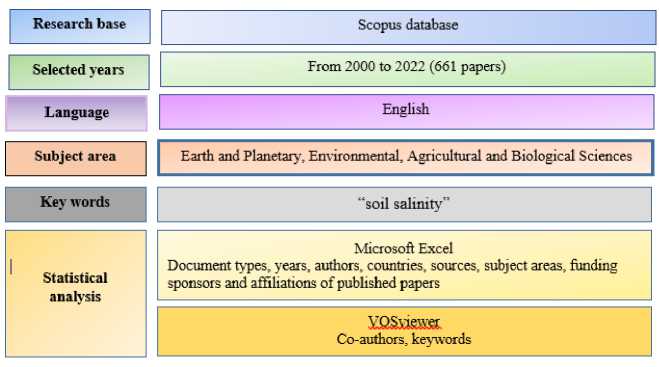
Fig. 1. Methodology flowchart.
Characteristics of soils in Central Asia
Soil type is the fundamental component of soil classification (light grey soils, typical grey soils, dark grey soils, brown, carbonate, brown leached, etc.). Despite adhering to general classification principles, various objective and subjective factors contribute to differences in soil classification among republics. For instance, subjective differentiation of various types of soil: in Kyrgyzstan, the climate, plants, and landscape lead to the development of chestnut and mountain-chestnut soils, unique to the region and not found in other republics. In the grey soils zone, light and typical grey soils are sub-types that are identified. The most common confusion arises from diagnosing soil in high-altitude regions. Pedologists in Kyrgyzstan identify high-mountain, desert, steppe, and meadow-steppe soil as high mountain half-peat, while in Uzbekistan they are known as light-brown and meadow-steppe soils. The transitional soils consist of meadow takyric soils, along with remnant meadow and swampy soils located in the dried area of the Amu-Darya delta. Coastal solonchaks and sand are the main features at the dry bottom of the Aral Sea. Light, typical, and dark grey soils are predominant in the lower belt of piedmont subtropical semidesert. Mountainous regions with subhumid and humid climate conditions are home to cinnamonic and brown soils.
RESULTS AND DISCUSSION
Trend of publications on soil salinity in Central Asia
A total number of 661 articles were released from 2000 to 2022 focusing on the problem of soil salinity in Central Asia (Fig. 2). The number of records began increasing between 2000 and 2022, going from 1 to 145 publications. Figure 2 illustrates that a total of 95 articles were released from 2000 to 2012, but there was a significant rise from 31 to 145 articles between years 2013 and 2021. The peak of publications occurred in 2021 with a total of 145 articles published during the analysis period. Around 13.6% of all publications were released in the year 2022.
In addition, our research indicates that the majority of the papers analyzed, specifically 65% of 661, were research articles. This was followed by 131 conference proceedings, 49 book chapters, and 48 review papers. Other document types, such as Editorials and Books, made up only 0.4% (Fig. 3).
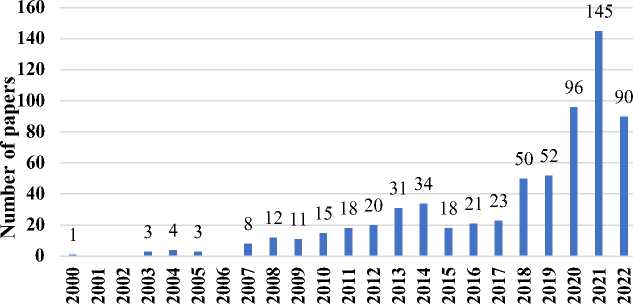
Year
Fig. 2. Number of papers on soil salinity in Central Asia from 2000 to 2022.
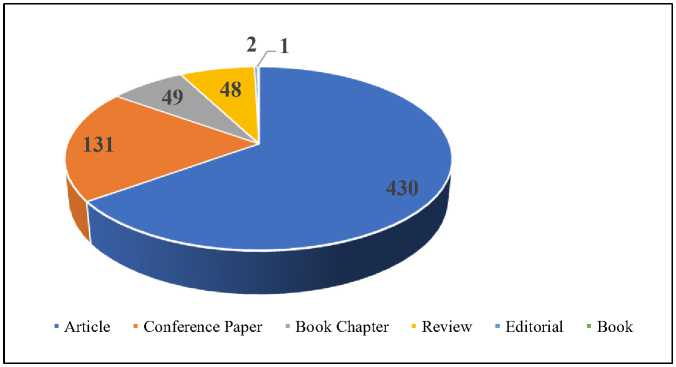
Fig. 3. Publication type on soil salinity in Central Asia.
Journals on soil salinity in Central Asia
The total output was divided among 141 journals from 90 countries according to the communication patterns of scholars. Out of the 15 journals, 212 papers (32%) were published in them while the remaining 68% of papers were published in different journals. Table 1 shows the names of the 42 journals that published at least 3 papers during the mentioned period.
Authors and their affiliated countries
A total of 860 authors from 90 different countries conducted research on soil salinity between the years 2000 and 2022, according to our findings. Figure 4 displays these ten authors who had produced over 12 papers. They are Egamberdieva, D. reigned with 46 publications, followed by Lamers, J.P.A. with 24, Martius, C. with 18, Wirth, S. with 16 papers, Jabborova, D. with 13, Shuyskaya, E.V., Abuduwaili, J., Khaitov, B., Toderich, K. and Toderich, K.N. each with 12 research papers. Between this list of top authors. Among the authors from the list there are three ones from Uzbekistan, three from Germany, two from Japan, one from Russia and one from Kazakhstan.
Over a span of two decades, 160 diverse organizations collaborated to release 661 documents on global soil salinity. Examining the publications on soil salinity from the top 10 institutes enabled us to identify the influential and productive institutions in this area. As shown in Figure 5, out of the 10 institutions, five were from Uzbekistan, two from China, two from Germany, and one from Kazakhstan. The Tashkent Institute of Irrigation and Agricultural Mechanization Engineers National Research University holds the top spot with 95 records, followed by the National University of Uzbekistan named after Mirzo Ulugbek with 82 records, and Tashkent State Agrarian University with 60 records.
Top countries on soil salinity research
The five top producing countries in the field of soil salinity research between 2000 and 2022 are listed in Figure 6. Among them, Uzbekistan dominated with 414 publications, followed by Kazakhstan (222), Germany (125), China (78) and the Russian Federation (59).
Table 1. List of the journals on soil salinity in Central Asia
|
Scopus Source title |
Number |
Scopus Source title |
Number |
|
E3s Web of Conferences |
53 |
Journal of Arid Environments |
5 |
|
Iop Conference Series Earth and Environmental Science |
36 |
Journal of Plant Nutrition |
5 |
|
News of The National Academy of Sciences of The Republic of Kazakhstan Series of Geology and Technical Sciences |
16 |
Saudi Journal of Biological Sciences |
5 |
|
Water Switzerland |
15 |
Advances in Colloid and Interface Science |
4 |
|
Journal of Critical Reviews |
14 |
Agriculture Switzerland |
4 |
|
Agricultural Water Management |
11 |
Communications in Soil Science and Plant Analysis |
4 |
|
Agronomy |
11 |
Polish Journal of Environmental Studies |
3 |
|
Plants |
11 |
Pollution Research |
3 |
|
Iop Conference Series Materials Science and Engineering |
8 |
Russian Journal of Ecology |
3 |
|
Online Journal of Biological Sciences |
7 |
Sustainability Switzerland |
3 |
|
Frontiers in Plant Science |
6 |
Field Crops Research |
4 |
|
Irrigation and Drainage |
6 |
Geoderma |
4 |
Table 1 continued
|
Scopus Source title |
Number |
Scopus Source title |
Number |
|
Journal of Arid Land |
6 |
Irrigation Science |
4 |
|
Journal of Ecological Engineering |
6 |
Journal of Agronomy and Crop Science |
4 |
|
Land Degradation and Development |
6 |
Journal of Hydrology |
4 |
|
Plant Cell Biotechnology and Molecular Biology |
6 |
Journal of Physics Conference Series |
4 |
|
Acta Physiologiae Plantarum |
5 |
Life Science Journal |
4 |
|
Aip Conference Proceedings |
5 |
Pakistan Journal of Botany |
4 |
|
Arid Ecosystems |
5 |
World Applied Sciences Journal |
4 |
|
Bulgarian Journal of Agricultural Science |
5 |
Biology and Fertility of Soils |
3 |
|
Frontiers in Microbiology |
5 |
||
|
Irrigation and Drainage Systems |
5 |
я
я
я

Fig. 4. Top authors on soil salinity in Central Asia.
Leibniz-Zentrum für…
International Center for Agricultural…
Al Farabi Kazakh National University
Tashkent State Agrarian University
Tashkent Institute of Irrigation and…
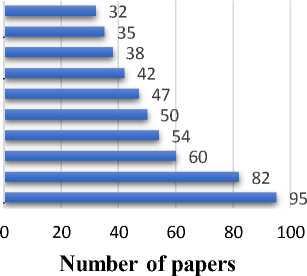
Fig. 5. Top of institutions on soil salinity.
Top cited papers on soil salinity in Central Asia
Ten mostly cited papers on soil salinity are shown in Table 2. (Ullrich et al., 2001; Egamberdieva et al., 2007, 2017, 2019; Egamber-dieva, 2009; Egamberdieva, Kucharova, 2009; Bezborodov et al., 2010b; Ventura et al., 2011; Sommer et al., 2013; Ivushkin et al.,
2019b). Approximately 2 541 citations were awarded to the 10 papers listed in Table 2. The first 10 most cited papers include two reviews and eight research articles. In this compilation of the most referenced articles, Uzbekistan has six representations, UK, Israel, Germany and Netherlands have one representative each.
Top cited journals on soil salinity in Central Asia
We examined the leading journals in Figure 7 that released the most papers. Considering this factor, we chose to research the most frequently cited journals regarding soil salinity. At first, we organized the names of the sources in alphabetical order for 661 documents with excel file extension. Each journal's total paper citations are calculated gradually. Surprisingly, we obtained intriguing outcomes when updating the list of possible journal titles. Figure 7 displays 10 selected journals chosen initially.
Top co-authorships and keywords on soil salinity in Central Asia
The original file was brought into VOSviewer and used to generate a visualization of co-authorship and keyword co-occurrences (refer to Figures 8, 9) within the program. The examination of coauthorship produced a network consisting of 860 authors. Only authors having a minimum of three publications on the topic of soil salinity systems were included. There are 82 items distributed over 14 clusters: cluster 1 (12 items), cluster 2 (11 items), cluster 3 (11 items), cluster 4 (8 items), cluster 5 (6 items), cluster 6 (6 items), cluster 7 (6 items), cluster 8 (5 items), cluster 9 (4 items), cluster 10 (4 items), cluster 11 (3 items), cluster 12 (3 items), cluster 13 (2 items), cluster 14 (1 items).
Role of drainage in soil salinity studies
Drainage is important to prevent waterlogging, poor mechanical movements and salinity. As a result of this recognition, drainage technology and theory have become topics of importance in the fields of soil, water, and agriculture (van der Zee et al., 2017).
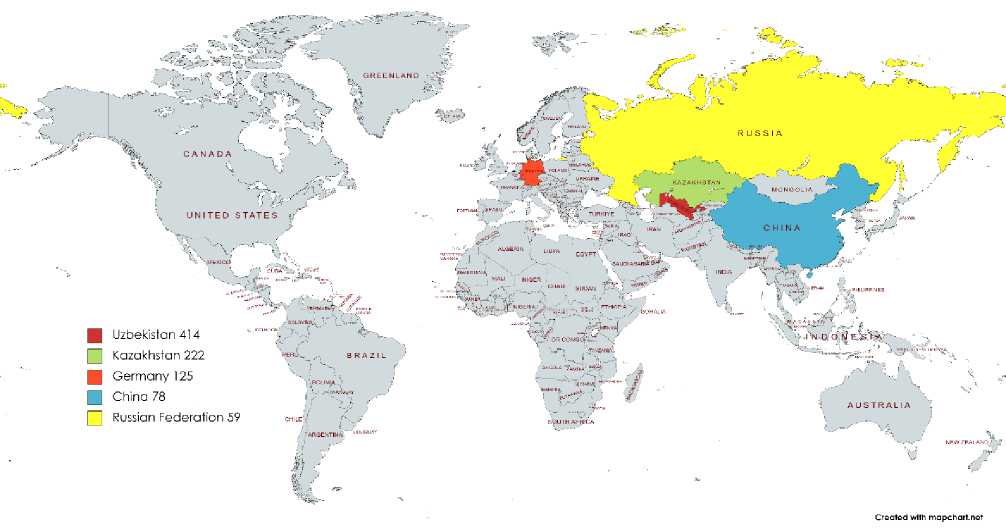
Fig. 6. Top of countries on soil salinity reserach.
Table 2. Top cited publications on soil salinity in Central Asia
|
No. |
Title |
Journal |
Corresponding author |
PY |
TC 20002022 |
Doc. type |
|
1. |
Mercury in the aquatic environment: A review of factors affecting methylation |
Critical Reviews in Environmental Science and Technology |
Ullrich S.M. |
2001 |
1170 |
Review |
|
2. |
Alleviation of salt stress by plant growth regulators and IAA producing bacteria in wheat |
Acta Physiologiae Plantarum |
Egamberdieva D. |
2009 |
233 |
Article |
|
3. |
High incidence of plant growthstimulating bacteria associated with the rhizosphere of wheat grown on salinated soil in Uzbekistan |
Environmental Microbiology |
Egamberdieva D. |
2008 |
202 |
Article |
|
4. |
Selection for root colonising bacteria stimulating wheat growth in saline soils |
Biology and Fertility of Soils |
Egamberdieva D. |
2009 |
187 |
Article |
|
5. |
Salt-Tolerant Plant Growth Promoting Rhizobacteria for Enhancing Crop Productivity of Saline Soils |
Frontiers in Microbiology |
Egamberdieva D. |
2019 |
131 |
Review |
Table 2 continued
|
No. |
Title |
Journal |
Corresponding author |
PY |
TC 20002022 |
Doc. type |
|
6. |
Effect of seawater concentration on the productivity and nutritional value of annual Salicornia and perennial Sarcocornia halophytes as leafy vegetable crops |
Scientia Horticulturae |
Ventura Y. |
2011 |
129 |
Article |
|
7. |
Mulching and water quality effects on soil salinity and sodicity dynamics and cotton productivity in Central Asia |
Agriculture, Ecosystems and Environment |
Bezborodov G.A. |
2010 |
127 |
Article |
|
8. |
Global mapping of soil salinity change |
Remote Sensing of Environment |
Ivushkin K. |
2019 |
124 |
Article |
|
9. |
Endophytic bacteria improve plant growth, symbiotic performance of chickpea (Cicer arietinum L.) and induce suppression of root rot caused by Fusarium solani under salt stress |
Frontiers in Microbiology |
Egamberdieva D. |
2017 |
121 |
Article |
|
10. |
Impact of climate change on wheat productivity in Central Asia |
Agriculture, Ecosystems and Environment |
Sommer R. |
2013 |
117 |
Article |
Note. * PY – Published year, * TC – Total citations.
-
□ Critical Reviews in Environmental Science and Technology
-
□ Acta Physiologiae Plantarum
-
□ Agricultural Water Management
-
□ Biology and Fertility of Soils 2
-
□ Agriculture, Ecosystems and
Environment
-
□ Environmental Microbiology I 202
-
□ Frontiers in Microbiology
-
□ Irrigation and Drainage Systems
-
□ Journal of Plant Interactions
-
□ Saudi Journal of Biological Sciences
Fig. 7. Top cited journals on soil salinity in Central Asia.
glushenkova a i
pulatov, a
yertayeva, z
oyiga, b c
- ... Ie°n j balivora. a
shurgm, v ciavranov, к egamberdieva, d
Shuyskaya, e v is ma II. s
beltrao. j
khaitov b todefjch, к ,^ sulwiAskj, m qa^ljf, гп yuldashev. t
!aiskh'anov, s u
horst, m g
alikulov z sagi, m
stulina, g

VOSviewer
Ibragimov, n sommer r
kulmatov r abuduwaili j
Fig. 8. Network map of top co-authorships.
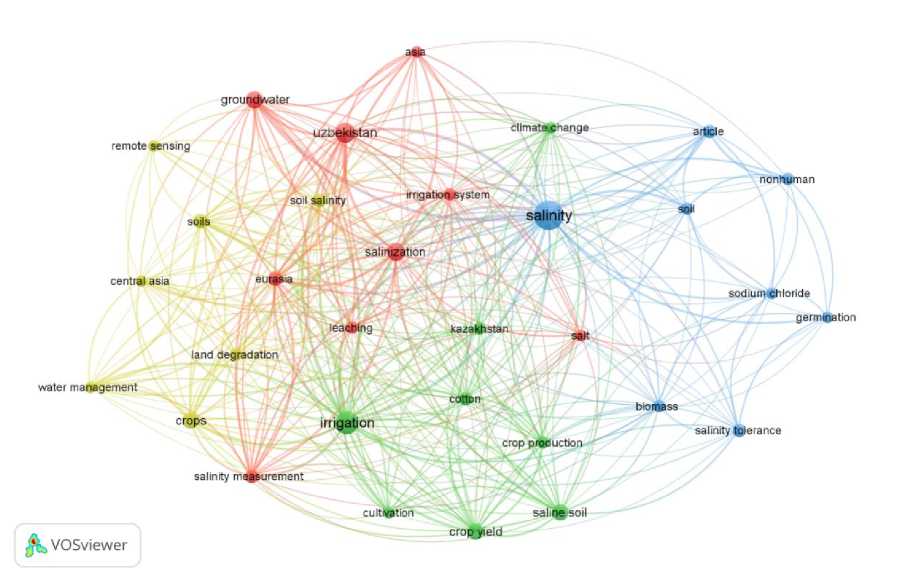
Fig. 9. Network map of top keywords.
Our analysis of the soil salinity publications for Central Asia countries during the mentioned period has shown that almost 40 (6%) publications emphasized the role of drainage. From one to nine papers were published between 2000–2022 on soil salinity issue. During the period of analysis, the pick of publications was reached in 2020, the number of papers amounted to 9. The drainage system based papers were published in 22 different journals with the high reputation. Almost 32 authors from different countries took a part in preparation of those research papers (Fig. 10).

Fig. 10. Drainage based papers on soil salinity in Central Asia.
This bibliometric analysis showed that articles published for over 20 years had the highest results on soil salinity studies in the last 5 years. Based on the research findings in Central Asia, Uzbekistan is at the forefront in terms of top institutions, top authors, and top cited publications in the field of soil salinity research. “Tashkent Institute of Irrigation and Agricultural Mechanization Engineers” of the National Research University is at the top of the ranking with 95 articles. It is due to the fact that this institution has consistently been ranked as the number one in Uzbekistan in recent times. Nonetheless, Germany, China, and Kazakhstan are the primary financial backers for this timeframe. There may be a significant reason for this, since these countries have a large number of highly regarded research centers and uni- versities. The territories of Central Asia of the irrigated lands are silted to varying degrees (Juliev et al., 2022). Soil salinization in Central Asia negatively impacts not only agriculture, but also various other aspects such as historical monuments, fortresses, buildings, electric wires, roads, pastures, and both human and animal communities, leading to substantial economic losses for the countries in the region (Gafurova, Juliev, 2021; Makhkamova et al., 2022). To solve the above problem, underlying all systems of measures to combat salinity and waterlogging in irrigated lands is a set of measures to prevent these negative situations. Among the many methods and techniques developed and tested in science and practical experiments to combat soil salinization, three are of great importance the following: drainage, high-quality land leveling (planning) and salt washing activities (Li et al., 2022). The operation of the drainage system is very important during quality land leveling (planning) and salt washing activities. Nearly all of the sown area, and most of it under industrial crops, is irrigated land, which is serviced by a powerful state drainage system (Kannazarova et al., 2021). Based on the quantitative analysis, it appears that the contexts are “salinity” with 61 documents representing 9.2% of the total count, followed by “irrigation” (38 documents), “Uzbekistan” (29 documents), “salinization” (25 documents). In this research, it is clear that almost 80% of the articles concern the deterioration of land reclamation related to the soil salinity. In the given data, groundwater levels have risen in Central Asia countries due to the lack of technical control in the drainage system (Balla et al., 2014), (Ayars et al., 2006), (Drovovozova et al., 2021). Insufficient attention to the technical monitoring of the drainage system in irrigated lands leads to the increase in soil salinity. This will result in more severe salinization of irrigated lands in the future. The main part of the irrigated lands in Central Asia is saline or is under the threat of salinization. Over half of the irrigated lands are characterized by the unsatisfactory and slightly satisfactory ameliorative condition. Irrigated lands of Turkmenistan are subjected to the most active processes of anthropogenic (secondary) salinization, on the territory of which saline soils occupy 80–90% of the area. In Uzbekistan, salinization affects about 60% of irrigated land, in Kyrgyzstan – 12%, in Tajikistan – 18% (Qadir et al., 2009; Çakir, 2020). The salinity of irrigated soils in Central Asia varies due to different origins: residual saliniza- tion, resulting from the original natural salinity of soils and rocks; secondary hydrogenous salinization, caused by the rise of groundwater or changes in the water regime of soils; and, finally, salinization associated with the influx of salts from the atmosphere and with irrigation waters. The first type of salt genesis prevails on newly irrigated lands; the second and third appear on the lands under both long-term and recent irrigation. The composition of salts and the degree of salinization of the irrigated soils of Central Asia vary greatly. Sulfate salinization is the main form of salt accumulation in continental regions with active desalinization processes. Regions where salt builds up at the end of irrigation and where marine sediments are found, even ancient ones, are known for chloride salt contamination. Soda spots in temporary zones are linked to the natural salt buildup in desert areas. In Tajikistan and Kyrgyzstan, there is evidence of consistent soda salinization in areas where hydrocarbonate-sodium waters are found. There is a risk of increased secondary salinization on the majority of irrigated lands in Central Asia, especially on areas where an irrigation-hydromorphic system has been implemented. In Central Asia, this system causes salt buildup on irrigated lands due to an increase in water rates in irrigation areas or in the drainage water discharge zone, which is inevitable. This, in turn, will inevitably lead to the activation of salt accumulation in soils and in the region as a whole. Salinization is also facilitated by the construction of a collector-drainage network, which involves deep-seated salt reserves and carries them into rivers, lakes and other bodies of water.
Soil Salinity in Central Asia
In the XX century, the method of watering of irrigated lands in Central Asia cannot be considered as effective enough, which can lead to a reduction of irrigated lands and an increase in salinity. Also, the dried-up Aral Sea has lost its role as a regulator of climate and geochemical runoff and has become a source of soil salinization, due to the aeolian transfer of salts to the surrounding lands. This led to a deterioration of the environmental situation in the region and created new environmental and economic problems in Central Asia. The negative environmental processes were also facilitated by the complex sociopolitical situation in the region that arose after the collapse of the
USSR. Until 1991, the republics of Central Asia were part of a single state. After the collapse of the USSR, the situation changed. This affected, first of all, water resources. Uzbekistan and Turkmenistan are particularly acutely experiencing a shortage of irrigation water. We attribute the development of secondary salinization in the region to old problems that arose as a result of the widespread development of irrigation in the XX century, which determined the transfer of automorphic soils to hydromorphic ones. We attribute environmental, social, and economic problems, that arose at the end of the XX and the beginning of the XXI centuries in connection with the drying up of the Aral Sea and the collapse of the USSR, to new problems. All of the above testifies to the fact that the lands in Central Asia are undergone degradation processes that aggravate the reclamation situation. Despite drainage facilities and other measures, aimed at improving the reclamation of irrigated lands, the proportion of land in satisfactory and unsatisfactory condition has not changed much in recent years.
CONCLUSIONS
This work is focused on soil salinity progress, research hotspots, and possible research directions in regions of Central Asia from 2000 to 2022 using bibliometric approaches based on the online Scopus database. In this bibliometric analysis, we have collected, reviewed, and analyzed 661 publications. The continued and rapid growth in the number of articles implies that soil salinity is gaining attention. Uzbekistan contributed the most publications (414), followed by Kazakhstan (222), Germany (125), China (78) and the Russian Federation (59). Between these publications, we can see that most of these articles were written on soil salinity in Uzbekistan and Kazakhstan. Through this analysis, we have seen that the salinization of the lands in Central Asian countries has become very serious and many factors have an influence on it. One of the core problems is the rise in groundwater levels. The main reason for this is that the performance of the drainage system in these countries is very low, and unfortunately, it is oftenly observed that it does not work at all. The lack of attention to the technical monitoring of the drainage system on irrigated lands provokes the main causes of soil salinity. This will lead to further salinization of irrigated lands in the future. Such a neglect may result in land fallout in the future, and affect not only agriculture, but also human health, animal loss, and political and economic difficulties in the Central Asian countries. The important reasons for this may be the inadequate data exchange system, the lack of international cooperation and consequent lack of joint projects. Proper management of all these issues can lead to more international collaborative projects and new publications, not only on soil salinity but also in other spheres. These issues should be addressed in the future. In addition, international research on soil salinity would benefit from increased scientific exchange on this topic, especially between emerging and developed countries, between agricultural and soil salinity and drainage science, and between stakeholders and scientists.

